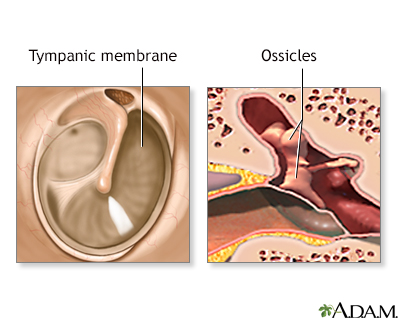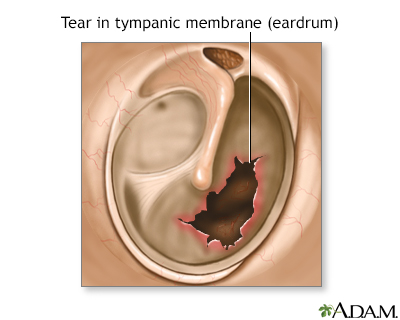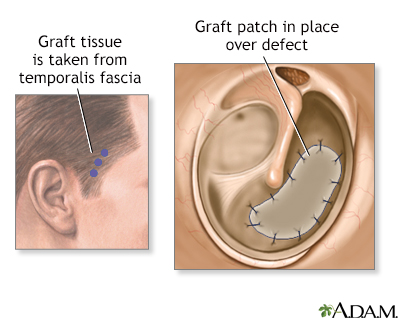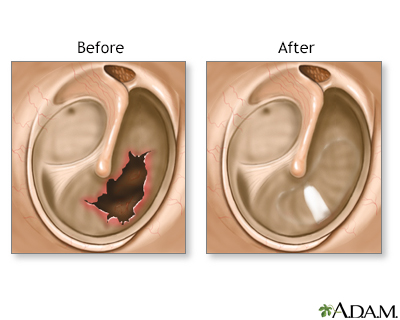Eardrum repair - series

Normal anatomy
The tympanic membrane (eardrum) separates the outer ear from the middle ear. The membrane vibrates when sound waves strike it, beginning the process that converts the sound wave into a nerve impulse that travels to the brain.

Indication
Ruptured or perforated eardrums are usually caused by middle-ear infections or trauma (for example, an object in the ear, a slap on the ear, explosions, or repeated, excessive ear pressure from flying or diving).
If healing does not occur with antibiotics or other non-operative treatment, surgery may be necessary.
Chronic middle ear infections are described as:
- 5 or more ear infections in a year, or
- 3 or more ear infections a year over a two-year period
Signs of chronic ear infections include persistent ear pain, ear drainage, or hearing loss (over a 3-month period).

Procedure
While the patient is deep asleep and pain-free, (general anesthesia), the surgeon grafts a small patch from the fascia of the forehead muscle (temporalis) onto the eardrum. This graft is used to repair the tear.
For problems with the small bones (ossicles), the surgeon will use an operating microscope to view and repair the chain of small bones using plastic devices or ossicles from a donor.

Aftercare
In most cases, the operation relieves pain and infection symptoms completely. Hearing loss is usually minor. However, if the ossicles require repair, outcome may be less optimal.
Patients usually leave the hospital the same day. After surgery, it is important to avoid getting water in the ear. Use a hair cap when showering for a few weeks.
Related Information
Cosmetic ear surgeryEardrum repair
Ear emergencies
Ear discharge
Ruptured eardrum
BACK TO TOP
Review Date: 5/2/2024
Reviewed By: Josef Shargorodsky, MD, MPH, Johns Hopkins University School of Medicine, Baltimore, MD. Also reviewed by David C. Dugdale, MD, Medical Director, Brenda Conaway, Editorial Director, and the A.D.A.M. Editorial team.

Health Content Provider
06/01/2025
|
A.D.A.M., Inc. is accredited by URAC, for Health Content Provider (www.urac.org). URAC's accreditation program is an independent audit to verify that A.D.A.M. follows rigorous standards of quality and accountability. A.D.A.M. is among the first to achieve this important distinction for online health information and services. Learn more about A.D.A.M.'s editorial policy, editorial process and privacy policy. A.D.A.M. is also a founding member of Hi-Ethics. This site complied with the HONcode standard for trustworthy health information from 1995 to 2022, after which HON (Health On the Net, a not-for-profit organization that promoted transparent and reliable health information online) was discontinued. |
The information provided herein should not be used during any medical emergency or for the diagnosis or treatment of any medical condition. A licensed medical professional should be consulted for diagnosis and treatment of any and all medical conditions. Links to other sites are provided for information only -- they do not constitute endorsements of those other sites. © 1997- 2025 A.D.A.M., a business unit of Ebix, Inc. Any duplication or distribution of the information contained herein is strictly prohibited.
